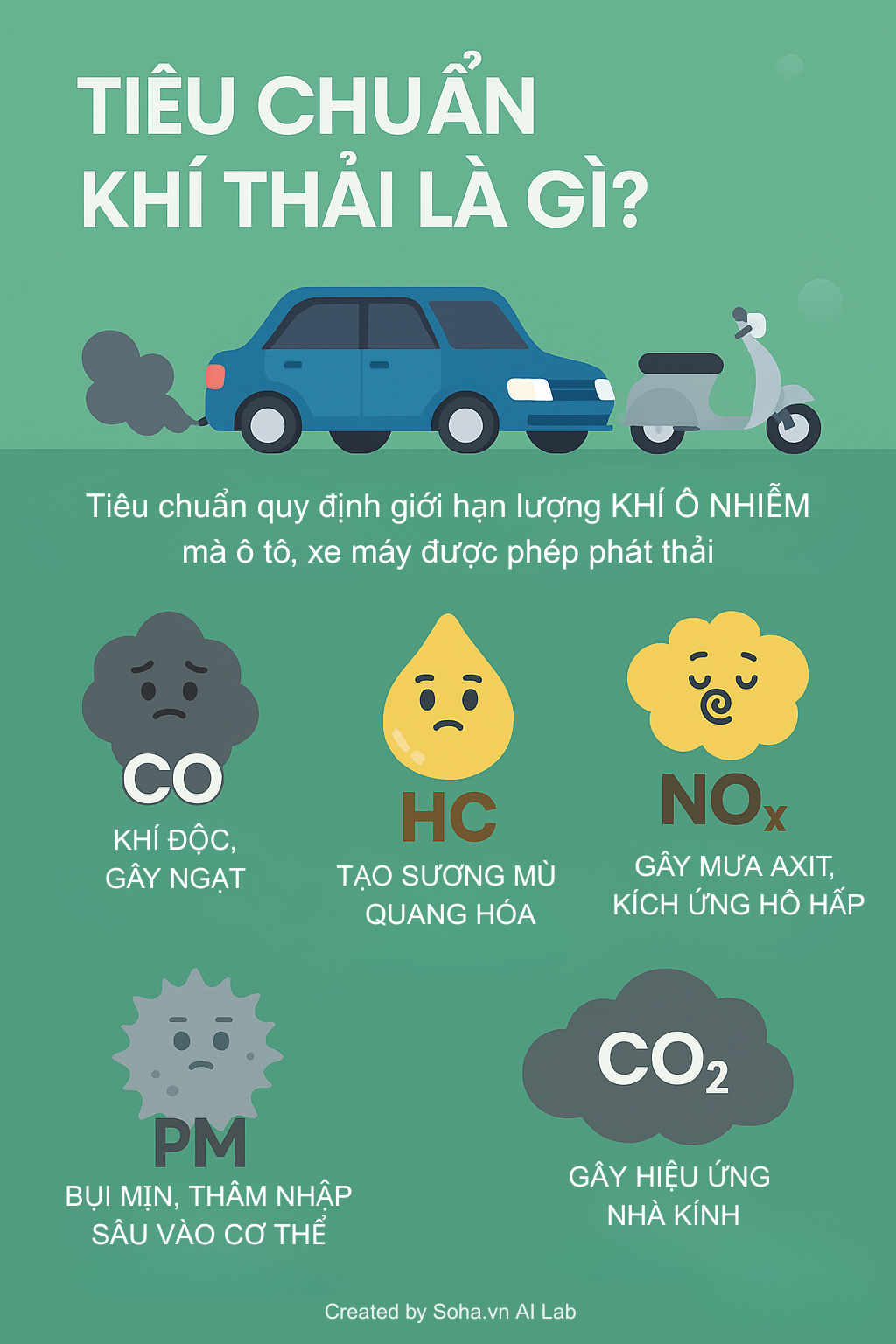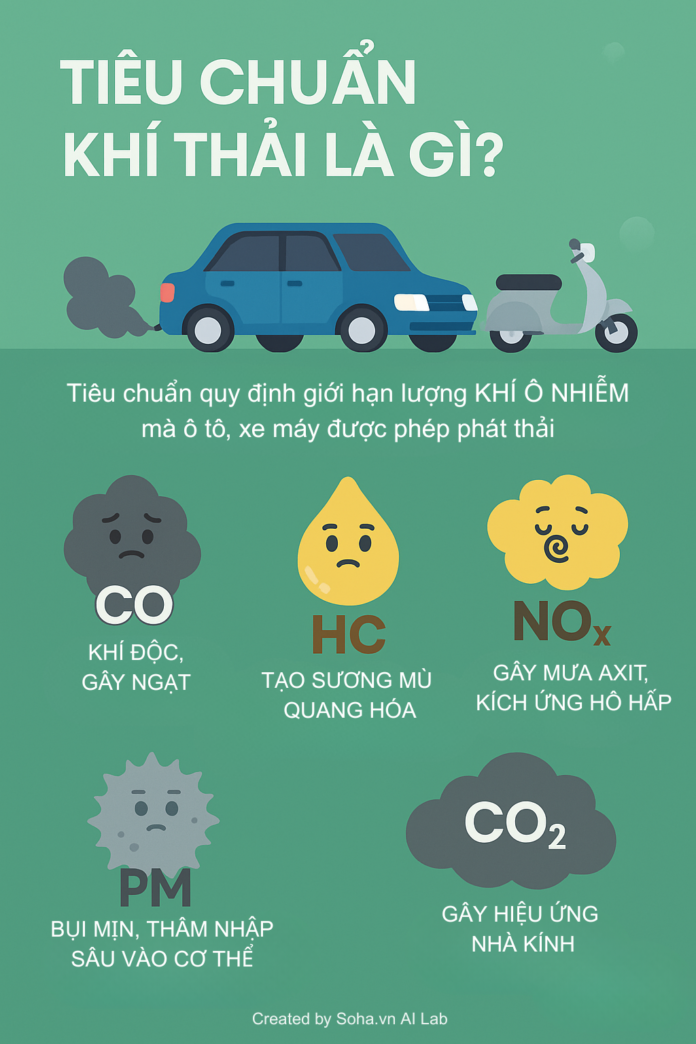The Ministry of Agriculture and Environment is currently seeking feedback on two draft regulations regarding emission standards and testing—one for automobiles and one for motorcycles—before submitting them to the government for official enactment later this year.
For the first time, Vietnam will establish a five-level classification system for automobile emissions, ranging from Level 1 (lowest) to Level 5 (highest). Hanoi and Ho Chi Minh City will take the lead in tightening standards, with vehicles registered in these cities required to meet Level 5 emissions by 2027, a year earlier than other provinces. Cars produced from 2022 onwards will need to attain Level 4 by 2026, while those manufactured before 1999 will only need to meet Level 1.
Regarding motorcycles, the roadmap is designed in three phases: starting from January 1, 2027, in Hanoi and Ho Chi Minh City, expanding to Hai Phong, Da Nang, Can Tho, and Hue in 2028, and nationwide implementation by 2030. If enforced as planned, emission testing for motorcycles will impact over 75 million vehicles currently in use, a significant portion of which are old gasoline-powered engines that do not meet emission standards.

Image caption
The most widely adopted and influential emission standard is currently the EURO standard, initiated by the European Union in 1992. Each EURO level (from EURO 1 to the current EURO 6d) tightens the limits on harmful emissions such as NOx (nitrogen oxides), HC (hydrocarbons), CO (carbon monoxide), and PM (particulate matter). For instance, the EURO 6 standard restricts NOx emissions to just 0.08g/km for diesel vehicles, an extremely stringent requirement compared to previous generations.
| EURO Emission Standards for Automobiles | |||||||||
| Standard |
Year of Application
(Passenger Cars)
|
CO (Gasoline)
(g/km)
|
HC (Gasoline)
(g/km)
|
NOx (Gasoline)
(g/km)
|
HC+NOx (Diesel)
(g/km)
|
NOx (Diesel)
(g/km)
|
PM (Diesel)
(g/km)
|
Heavy-Duty Vehicles Only
(g/kWh)
|
Notes |
| EURO 1 | 1992 | 2.72 | 0.97 | 0.97 | – | Initial Implementation | |||
| EURO 2 | 1996 | 2.2 | 0.5 | 0.7 | – | Reduced Limits | |||
| EURO 3 | 2000 | 2.3 | 0.2 | 0.15 | 0.56 | 0.5 | 0.05 | Euro III: 5.0 NOx | Separate NOx Limit |
| EURO 4 | 2005 | 1 | 0.1 | 0.08 | 0.3 | 0.25 | 0.025 | Euro IV: 3.5 NOx | PM Control Introduced |
| EURO 5 | 2009 | 1 | 0.1 | 0.06 | 0.23 | 0.18 | 0.005 | Euro V: 2.0 NOx | Strict NOx and PM Limits |
| EURO 6 | 2014 | 1 | 1 | 0.06 | 0.17 | 0.08 | 0.005 | Euro VI: 0.4 NOx | RDE Testing Introduced |
| EURO 6d | 2021 | 1 | 1 | 0.06 | 0.17 | 0.08 | 0.005 | Euro VI-d: 0.4 NOx | Mandatory RDE, Strictest Standard |
Vietnam currently adheres to these EURO standards. Specifically, since 2017, newly produced automobiles must meet at least EURO 4 standards, and from 2022, diesel-powered vehicles are required to attain EURO 5. For motorcycles, the EURO 3 standard has been in effect since 2017. However, there are virtually no emission testing requirements for vehicles already in use, especially older motorcycles, which has led to a significant volume of emissions in urban areas.
| EURO Emission Standards for Motorcycles | |||
| Standard | Year of Application | Applicability | Notes |
| EURO 1 | 1999 | Motorcycles and Mopeds | Initial Standard |
| EURO 2 | 2003 | Vehicles below and above 50cc | Significant Reduction in HC and CO |
| EURO 3 | 2006 | All Motorcycle Engine Sizes | NOx Control Introduced |
| EURO 4 | 2016 | Newly Registered Motorcycles | Strict Limits on CO, HC, NOx; EVAP Testing |
| EURO 5 | 2020–2021 | Comprehensive Application | Stringent Standards, Comparable to EURO 6 for Automobiles |
| In Vietnam * EURO 2 for motorcycles was implemented in 2007 * EURO 3 for motorcycles produced after 1/1/2017 However, there has been no emission testing for motorcycles already in use, an issue that the new regulations aim to address from 2027 onwards in Hanoi and Ho Chi Minh City |
With air quality in major cities frequently reaching alarming levels, the introduction of stricter emission standards necessitates bold, scientific, and humane decisions. These new regulations will not only improve living environments and public health but also incentivize technological advancements and the adoption of cleaner vehicles, thereby fostering a green and sustainable economy. Owners of old gasoline-powered motorcycles will have the opportunity to transition to electric vehicles with technical, policy, and financial support from the government.
The challenges are significant, ranging from inspection infrastructure and clean fuel availability to enforcement capabilities. However, if effectively implemented, these policies will allow millions of Vietnamese citizens to breathe cleaner air, a basic yet “luxurious” amenity in urban areas.
Luong Truong
















